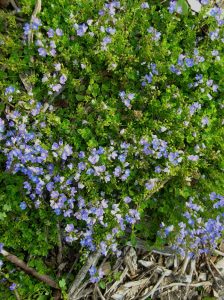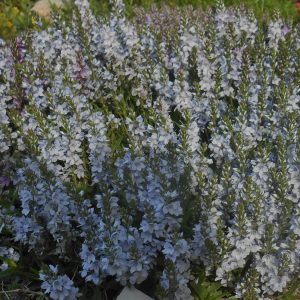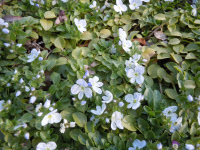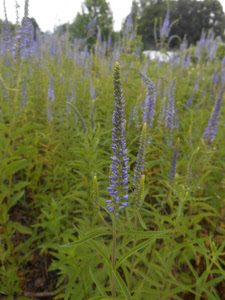Shop
Showing 761–768 of 778 results
-
Veronica incana syn. V. spicata subsp. incana Silver speedwell, Hoary Veronica Z 4-9
Erect blue racemes June – September atop gray foliage give a serene effect
ARCHIVED
Note: This is a plant not currently for sale. This is an archive page preserved for informational use.
Erect blue racemes June – September atop gray foliage give a serene effect
Size: 12-18” x 12”
Care: sun to part shade in well-drained to moist well-drained soil
Native: mountains & fields of UkraineIntroduced from Russia by 1759. LH Bailey declared it “has a good appearance both in and out of bloom; useful in the rockery, border or geometrical garden.” (1933)
-
Veronica liwanensis Turkish speedwell Z 4-8
Tiny true blue saucers smother the ground
OUT OF STOCK
Tiny true blue saucers smother the ground in May & June – groundcover, front of border or rock garden plant.
Size: 1” x 18” spreader over time
Care: sun to part shade in moist well-drained to well-drained soil
Native: NE Anatolia, Caucasus
Wildlife Value: attracts butterflies
Awards: 1997 Plant Select Winner.Collected before 1849.
-
Veronica officinalis Common speedwell Z 3-7
Mat-forming perennial with spikes of blue flowers with darker blue stripes on the petals, May-August
OUT OF STOCK
Mat-forming perennial with spikes of blue flowers with darker blue stripes on the petals, May-August
Size: 4-12” x 6”
Care: sun in dry, well-drained soil
Native: Europe and Asia
Wildlife Value: attracts beesUsed in European traditional medicine as a cough remedy and tonic as well as a salve. Used for centuries as a cure-all medicinal as long ago as ancient Rome. Grown at America’s 1st botanic garden, Elgin Botanic Garden 1811.
-
Veronica oltensis Turkish-leaf speedwell, Thyme-leaf speedwell Z 4-9
Tiny azure flowers smother the ground in spring-early summer on this groundcover or rock garden plant, or grow in walkway crevices.
ARCHIVED
Note: This is a plant not currently for sale. This is an archive page preserved for informational use.
Tiny azure flowers smother the ground in spring-early summer on this groundcover or rock garden plant, or grow in walkway crevices.
Size: 1" x 24" slow spreader
Care: sun to part shade in well-drained soil
Native: Mountain valleys of Oltu and Coruh inTurkey.Described in literature in 1914.
-
Veronica porphyriana Bird’s-eye speedwell Z 3-8
June – September (WOW!) short blue-purple, more blue than purple, spikes of compact flowers bloom on short, slowly creeping mat of sword-shaped foliage that suppresses weeds.
June – September (WOW!) short blue-purple, more blue than purple, spikes of compact flowers bloom on short, slowly creeping mat of sword-shaped foliage that suppresses weeds.
Size: 6-8” x 12”
Care: sun to part shade in well-drained soil
Native: Siberia, Mongolia & Kazakhstan
Wildlife Value: attracts pollinators. Drought tolerant; deer and rabbit resistantAccording to Christian tradition, as Jesus carried the cross to Calvary, a woman wiped his face with her handkerchief, leaving the imprint of the features of his face, the vera iconica, meaning “true likeness.” When the Catholic Church canonized the woman, the Church gave her the name Saint Veronica. Medieval gardeners named a different Veronica after her due to the perceived likeness of the flower to her handkerchief. Collected by 1950 Russian botanist Nikolái Pávlov (1893-1971) described and named this in Vestn. Akad. Nauk Kazakhsk. S.S.R v.4 p. 92 (Academy of Sciences of the Kazakh SSR) in 1951. Kazakh is the name of the language of people of Central Asia inhabiting mainly Kazakhstan which became independent of Russia in 1991.
-
Veronica prostrata syn. V. rupestris Sprawling speedwell, Harebell speedwelll Z 4-8
From midspring to midsummer short blue spikes above prostrate foliage.
OUT OF STOCK
From midspring to midsummer short blue spikes above prostrate foliage.
Size: 6” x 18”spreads
Care: sun to part shade in moist well-drained soil.
Native: Europe
Wildlife Value: Deer and rabbit resistant.
Awards: Royal Horticultural Society Award of Garden Merit.In gardens since at least 1753 (Linnaeus). Bloomed for 4 or more months in rock garden at Edinburgh Botanic Garden (The Garden, Jan. 1876.)
-
Veronica repens Creeping speedwell Z 5-9
Palest of blue blooms in spring
OUT OF STOCK
Palest of blue blooms in spring on this low, creeping groundcover.
Size: 2” x 8-12”
Care: full sun to part shade in moist to moist well-drained soil
Native: CorsicaAccording to Christian tradition, as Jesus carried the cross to Calvary a woman wiped his face with her handkerchief, leaving the imprint of Christ’s features, the vera iconica, meaning “the true likeness.” When the Catholic Church canonized the woman the Church named her Saint Veronica. Medieval gardeners named the plant after her due to a perceived likeness of the flower to her handkerchief. This species collected by 1800. According to William Robinson, father of the mixed perennial garden, Veronica repens “clothes the soil with a soft carpet of bright green foliage, covered in spring with pale bluish flowers.”
-
Veronica spicata Speedwell Z 4-8
Blue spikes with a hint of lilac
Bluish-purple spikes all summer, if deadheaded
Size: 24" x 18-24"
Care: Sun in well-drained soil
Native: Hilly pastures in Europe and North Asia
Wildlife Value: attracts butterfliesAccording to Christian tradition, as Jesus carried the cross to Calvary a woman wiped his face with her handkerchief, leaving the imprint of Christ’s features, the vera iconica, meaning “the true likeness.” When the Catholic Church canonized the woman, the Church gave her the name Saint Veronica. Medieval gardeners named the plant after her due to a perceived likeness of the flower to her handkerchief. Veronicas have been in cultivation since at least Medieval times. Europeans made tea from V. spicata. In 1693 a symmetrical garden at Versailles used speedwell. V. spicata is a parent to many hybrid cultivars.







